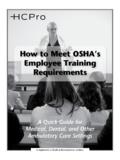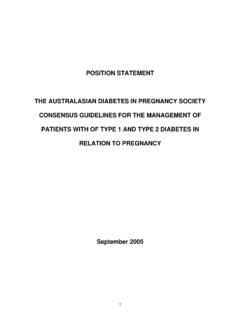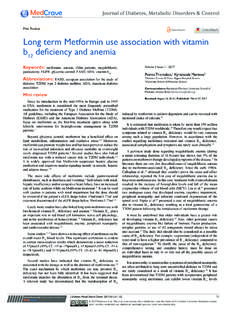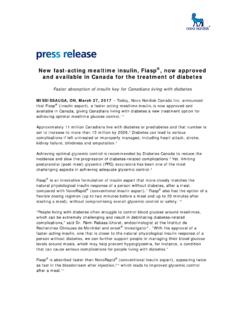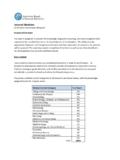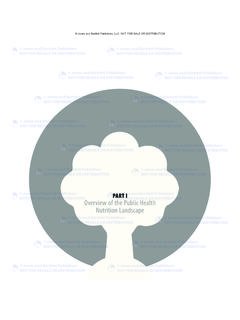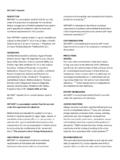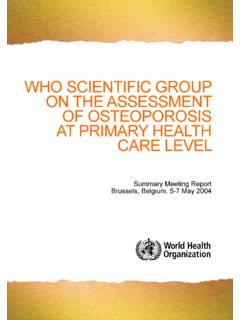Transcription of SECTION N: MEDICATIONS - HCPro
1 CMS's RAI Version Manual CH 3: MDS Items [N]. SECTION N: MEDICATIONS . Intent: The intent of the items in this SECTION is to record the number of days, during the last 7. days (or since admission/reentry if less than 7 days) that any type of injection, insulin, and/or select oral MEDICATIONS were received by the resident. N0300: Injections Item Rationale Health-related Quality of Life Frequency of administration of medication via injection can be an indication of stability of a resident's health status and/or complexity of care needs. Planning for Care Monitor for adverse effects of injected MEDICATIONS . Although antigens and vaccines are not considered to be MEDICATIONS per se, it is important to track when they are given to monitor for localized or systemic reactions. Steps for Assessment 1. Review the resident's medication administration records for the 7-day look-back period (or since admission/reentry if less than 7 days).
2 2. Review documentation from other health care locations where the resident may have received injections while a resident of the nursing home ( , flu vaccine in a physician's office, in the emergency room as long as the resident was not admitted). 3. Determine if any MEDICATIONS were received by the resident via injection. If received, determine the number of days during the look-back period they were received. Coding Instructions Record the number of days during the 7-day look-back period (or since admission/reentry if less than 7 days) that the resident received any type of medication , antigen, vaccine, etc., by subcutaneous, intramuscular, or intradermal injection. Insulin injections are counted in this item as well as in Item N0350. Count the number of days that the resident received any type of injection while a resident of the nursing home. Record the number of days that any type of injection was received in Item N0300.
3 May 2010 Page N-1. CMS's RAI Version Manual CH 3: MDS Items [N]. N0300: Injections (cont.). Coding Tips and Special Populations For subcutaneous pumps, code only the number of days that the resident actually required a subcutaneous injection to restart the pump. If an antigen or vaccination is provided on 1 day, and another vaccine provided on the next day, the number of days the resident received injections would be coded 2 days. If two injections were administered on the same day, the number of days the resident received injections would be coded 1 day. Examples 1. During the 7-day look-back period, Mr. T. received an influenza shot on Monday, a PPD test (for tuberculosis) on Tuesday, and a Vitamin B12 injection on Wednesday. Coding: N0300 would be coded 3. Rationale: The resident received injections on 3 days during the 7-day look-back period. 2. During the 7-day look-back period, Miss C. received both a influenza shot and her vitamin B12 injection on Thursday.
4 Coding: N0300 would be coded 1. Rationale: The resident received injections on 1 day during the 7-day look-back period. N0350: Insulin Item Rationale Health-related Quality of Life Insulin is a medication used to treat diabetes mellitus (DM). Individualized meal plans should be created with the resident's input to ensure appropriate meal intake. Residents are more likely to be compliant with their DM diet if they have input related to food choices. May 2010 Page N-2. CMS's RAI Version Manual CH 3: MDS Items [N]. N0350: Insulin (cont.). Planning for Care Orders for insulin may have to change depending on the resident's condition ( , fever or other illness) and/or laboratory results. Ensure that dosage and time of injections take into account meals, activity, etc., based on individualized resident assessment. Monitor for adverse effects of insulin injections ( , hypoglycemia). Monitor HbA1c and blood glucose levels to ensure appropriate amounts of insulin are being administered.
5 Steps for Assessment 1. Review the resident's medication administration records for the 7-day look-back period (or since admission/reentry if less than 7 days). 2. Determine if the resident received insulin injections during the look-back period. 3. Determine if the physician (or nurse practitioner, physician assistant, or clinical nurse specialist if allowable under state licensure laws and Medicare) changed the resident's insulin orders during the look-back period. 4. Count the number of days insulin injections were received and/or changed. Coding Instructions for N0350A. Enter in Item N0350A, the number of days during the look-back period that insulin injections were received. Coding Instructions for N0350B. Enter in Item N0350B, the number of days during the look-back period that the physician (nurse practitioner, physician assistant, or clinical nurse specialist if allowable under state licensure laws and Medicare) changed the resident's insulin orders.
6 Coding Tips and Special Populations A sliding scale dosage schedule that is written to cover different dosages depending on lab values does not count as an order change simply because a different dose is administered based on the sliding scale guidelines. If the sliding scale order is new, discontinued, or is the first sliding scale order for the resident, these days can be counted and coded. For subcutaneous insulin pumps, code only the number of days that the resident actually required a subcutaneous injection to restart the pump. May 2010 Page N-3. CMS's RAI Version Manual CH 3: MDS Items [N]. N0400: MEDICATIONS Received Item Rationale Health-related Quality of Life MEDICATIONS are an integral part of the care provided to residents of nursing homes. They are administered to try to achieve various outcomes, such as curing an illness, diagnosing a disease or condition, arresting or slowing a disease's progress, reducing or eliminating symptoms, or preventing a disease or symptom.
7 Residents taking MEDICATIONS in these drug classes are at risk of side effects that can adversely affect health, safety, and quality of life. While assuring that only those MEDICATIONS required to treat the resident's assessed condition are being used, it is important to reduce the need for or maximize the effectiveness of MEDICATIONS for all residents. Therefore, as part of all medication management, it is important for the interdisciplinary team to consider non-pharmacological approaches. Educating the nursing home staff and providers about non- pharmacological approaches in addition to and/or in conjunction with the use of medication may minimize the need for MEDICATIONS or reduce the dose and duration of those MEDICATIONS . Planning for Care The indications for initiating, withdrawing, or withholding medication (s), as well as the use of non- pharmacological interventions, are determined by assessing the resident's underlying condition, current signs and symptoms, and preferences and goals for treatment.
8 This includes, where possible, the identification of the underlying cause(s), since a diagnosis alone may not warrant treatment with medication . May 2010 Page N-4. CMS's RAI Version Manual CH 3: MDS Items [N]. N0400: MEDICATIONS Received (cont.). Target symptoms and goals for use of these MEDICATIONS should be established for each resident. Progress toward meeting the goals should be evaluated routinely. Possible adverse effects of drugs in each of these drug groups should be well understood by nursing staff. Educate nursing home staff to be observant for these adverse effects. Implement systematic monitoring of each resident taking any of these MEDICATIONS to identify adverse consequences early. Steps for Assessment 1. Review the resident's medical record for documentation that any of these MEDICATIONS were received by the resident during the 7-day look-back period (or since admission/reentry if less than 7 days).
9 2. Review documentation from other health care settings where the resident may have received any of these MEDICATIONS while a resident of the nursing home ( , valium given in the emergency room). Coding Instructions Check A, antipsychotic: if antipsychotic medication was received by the resident at any time during the 7-day look-back period (or since admission/reentry if less than 7 days). Check B, antianxiety: if anxiolytic medication was received by the resident at any time during the 7-day look-back period (or since admission/reentry if less than 7 days). Check C, antidepressant: if antidepressant medication was received by the resident at any time during the 7-day look-back period (or since admission/reentry if less than 7 days). Check D, hypnotic: if hypnotic medication was received by the resident at any time during the 7-day look-back period (or since admission/reentry if less than 7 days). Check E, anticoagulant ( , warfarin, heparin, or low- molecular weight heparin): if anticoagulant medication was received by the resident at any time during the 7-day look-back period (or since admission/reentry if less than 7 days).
10 Do not code antiplatelet MEDICATIONS such as aspirin/extended release, dipyridamole, or clopidogrel here. Check F, antibiotic: if antibiotics were received by the resident at any time during the 7-day look-back period (or since admission/reentry if less than 7 days). May 2010 Page N-5. CMS's RAI Version Manual CH 3: MDS Items [N]. N0400: MEDICATIONS Received (cont.). Check G, diuretic: if diuretics were received by the resident at any time during the 7- day look-back period (or since admission/reentry if less than 7 days). Check Z, none of the above were received: if none of the MEDICATIONS in Item N0400 were received during the 7-day look-back period (or since admission/reentry if less than 7 days). Coding Tips and Special Populations Code MEDICATIONS according to a drug's pharmacological classification, not how it is used. For example, oxazepam may be used as a hypnotic, but it is classified as an antianxiety medication .


